Geese are of different colors; they can be gray, brown, black, or white. In some cases, they can have a combination of colors. White geese can also be pure white or with some blend of other colors. Interestingly, the color of geese’ feathers is usually inherited from their parents. This can also be achieved through crossbreeding.
White geese are typically non-aggressive and are known for their calm dispositions, especially the domestication ones. Females will only attack if their eggs or babies are threatened. But some goose breeds are naturally territorial and may become aggressive to protect their space.
When placed together in a flock, some white geese breeds may be mistaken for others, especially if they are closely related. Some of them may also have almost the same sizes. This is why it is very important that you know their differences. To help you out, here are 10 different breeds of white geese.
10 White Geese Breeds
West of England Goose
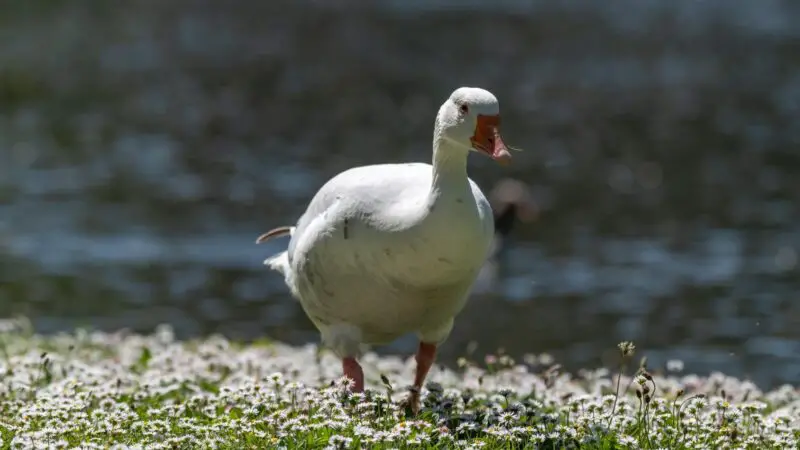
Appearance
The West of England goose has a gray and white pattern, blue eyes, and a dual-lobed protruding abdomen. Females have gray markings on their head, neck, and back and some gray patches on the beak. Meanwhile, males also have white plumage but gray markings on the body and a pale orange beak.
Lifespan
There is no official record showing the average lifespan of the West of England goose. However, most geese species can live between 20 and 25 years in the wild. Larger species have a shorter lifespan, though. Since West of England geese are medium-sized, they probably would live between 20 and 22 years.
Height
There are no documents that describe the estimated size of West of England geese. In fact, little is written about them. But according to the British Waterfowl Association (BWA), this rare goose breed is medium-sized and is a bit larger than the pilgrim goose, also known as the Australian settler goose.
Weight
Male West of England geese weigh between 7.3 and 9.1kilos (16 and 20 lbs), while females weigh between 6.3 to 8.2 kilos (13.8 and 18.0 pounds).
Wingspan
There is no official record stating the wingspan of West of England geese. But to give you an idea, pilgrim geese have an average wingspan of 88 inches (2.24 meters).
Place of Origin
This West of England goose originated in Cornwall and Devon in South West England, hence the name. Despite being an ancient bird, it was only in 1999 when the West of England goose was standardized by the British Waterfowl Association. The Rare Breeds Survival Trust included this bird on their watch list.
Characteristics
The West of England goose is an autosexing breed, which means that the gender of newly hatched goslings can easily be identified through their colors and markings. Females lay about 30-40 eggs in the spring, each weighing 130-200 grams. Both sexes are calm, friendly, and cold-hardy and grow very quickly.
White African Goose
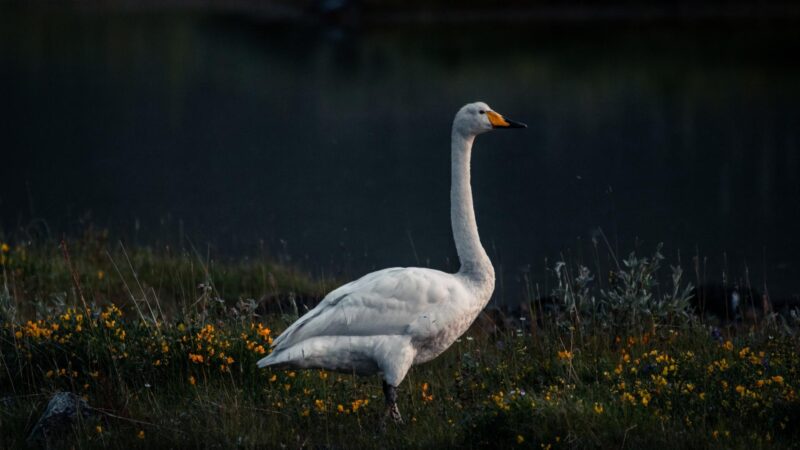
Appearance
As the name suggests, white African geese have pure white plumage. It also has an orange beak, a round abdomen, and a noticeable crescent-shaped dewlap. A dewlap is a fold of loose skin hanging from below the beak. Some of them don’t have a dewlap, though. Adults have big eyes and a fairly upright muscular body.
The African goose has two other color varieties – the buff and the brown or gray. Generally speaking, all three colors of African geese have brown-orange to bright orange feet and legs. Males have a larger knob (bump on the head) as compared to females. Older females tend to have a more noticeable paunch.
Lifespan
The white African goose has an average lifespan of between 10 and 15 years.
Height
White African geese can be as tall as 3 feet, and males are quite taller than females. While there are no records showing how big the African goose is, this magnificent goose breed is said to be as big as the Emden goose. Younger African geese are a bit smaller than young Emden geese, though.
Weight
Male African geese weigh about 22 pounds (10 kilos), while females weigh around 18 pounds (8 kilos). Young males that are 15 to 18 weeks old can weigh 16 to 18 pounds (7.2 to 8 kilos).
Wingspan
The white African goose can have a wingspan of up to 2.1 meters (6.9 feet).
Place of Origin
The origin of the white African goose is quite blurry since it was brought to the US by ship through different continents. But despite its name, it is not a native of Africa. Instead, African geese are closely related to the Chinese goose. They are a result of crossing the Toulouse gander and the brown Chinese goose.
The original brown African goose was admitted to the American Poultry Association (APA) Standard of Perfection in 1874. The white African goose was standardized in the UK in 1982 and was admitted to the APA in 1987. However, this white variety is quite rare, as compared to the brown and buff varieties.
Characteristics
If properly managed, the white African goose can lay eggs in their first year and can be used as a meat bird. Each gender can mate with 2-6 geese. Both sexes are keelless, which means that they cannot fly. African geese can thrive in considerable cold weather, but their knobs should be protected from frostbite.
White African geese tend to be calm but are more talkative than most goose breeds. They are generally friendly and docile but are occasionally aggressive. Nonetheless, domesticated females may attack people who go near their young.
Snow Goose
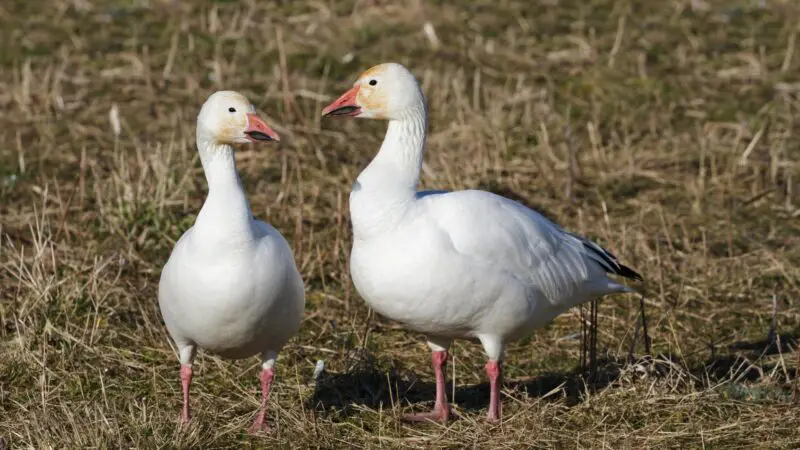
Appearance
As the name implies, Snow geese have white feathers. This goose species has two phases – the snow white and the blue (lesser snow) phase. Lesser snow geese tend to be more common than Snow white geese. In the past, people thought that these two color varieties belong to different species, but they are not.
Despite having different feather colors, both of them have pink beaks, red feet, black wing tips, and a black “grin patch.” This patch is the skin surrounding the beak and looks like a smile. Younger Snow geese look similar to adults, except that the color of their legs and feet is quite lighter.
Lifespan
On average, they are said to have a quite long lifespan and could live for 24.5 years. Meanwhile, a report said that a snow goose was killed by a hunter 15 years after it was banded (marked) in 1957. The mortality rate is about 20-50%.
Height
Adult Snow geese stand 63.5-78.7 cm (25-31 inches) tall and are around 70 cm (27.5 in) long.
Weight
Adult Snow geese weigh 2-3 kilos (4.4-6.6 lbs).
Wingspan
Adult Snow geese have a wingspan of about 54 inches (1.37 m).
Place of Origin
Scientifically known as Anser caerulescens, the snow goose is native to North America and is widely distributed across the continent. The population of this goose breed increased rapidly in the late 1990s, thus causing significant damage to agriculture. To solve this problem, periodic but regulated hunting was allowed.
Characteristics
As migratory game birds, snow geese fly South during winter and leave again in March to head north. But then, they prefer breeding in coastal lagoons, rocky terrains, and marshy areas. This white goose breed is aggressive and loves to travel in huge flocks, but likely to return to its nesting grounds every year.
Slovak White Goose

Appearance
Nothing much is written about how Slovak white geese look, except that they are pure white and have a very attractive appearance. Because of this, this domestic breed of goose was associated with grazing with young girls in the past. Hence, it became the subject of several poems and songs in their native country, Slovakia.
Lifespan
In the wild, Slovak white geese have an average lifespan of 12 years. On the other hand, the domesticated ones live up to 27 years.
Height
There are no documents explaining the size of the Slovak white goose, except that they are medium-sized. But to give an idea, a group of 2-5 individuals will need a waterer of 1.0 x 1.0 x 0.4 meters.
Weight
Male Slovak white geese weigh about 7 kilos (15.4 lbs), while females weigh around 6 kilos (13.2 lbs). With extensive breeding, four-month-old geese can already weigh 4 kilos (8.8 pounds).
Wingspan
They have a wingspan of about 54 inches (1.37 m).
Place of Origin
The Slovak white goose is native to Nitra, Slovakia. Locally known as Slovenská Biela hus, this goose breed was said to have been bred by a certain Július Godál in the 1940s. Unfortunately, the breeding population of Slovak white geese is now very low. This bird is now classified as an endangered species in the country.
Characteristics
The Slovak white goose is quite easy to feed and take care of in small-scale farming. This goose breed eats apples, cabbage, carrots, fine hay, and oats. But because Slovak white goose is a rustic goose breed, grazing is a requirement. It can also watch over lawns while grazing and produces feathers, liver, and meat.
Ross’s Goose
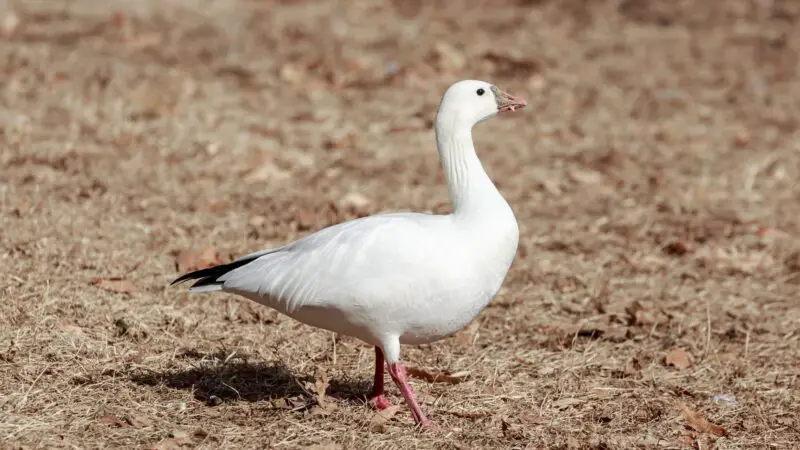
Appearance
Ross’s geese look like snow geese, except that they are a bit smaller. They also have two color phases – the white phase and the blue phase. The white Ross’s goose has pure white feathers, a pink beak, a short neck, and black wing tips. The blue morph Ross’s goose has a blue-green warty patch on the upper part of its beak. This dark morph was first documented in 1979 and is extremely rare.
Lifespan
The average lifespan of Ross’s geese in the wild is 22.5 years.
Height
Adult Ross’s geese are about 23 inches (58.4 cm) long.
Weight
Adult Ross’s geese weigh around 1.2 kilos (2.7 lbs.).
Wingspan
They have a wingspan of about 54 inches (1.37 m).
Place of Origin
The scientific name of Ross’s goose is Chen rossii. The bird was named after Canadian naturalist Bernard R. Ross, who collected data and specimens of the bird in the Northwest Territories of Canada from 1848-1862. The Ross’s goose was called “Horned Wavey” in 1771 by English explorer Samuel Hearne.
Characteristics
As migrating birds, Ross’s geese leave their nesting grounds in mid-October and come back in April. Nearly 90% of the population of Ross’s geese can be found in the Queen Maud Gulf Migratory Bird Sanctuary in Canada. Since Ross’s goose is typically not aggressive and will attack only if they are being threatened.
Emden Goose
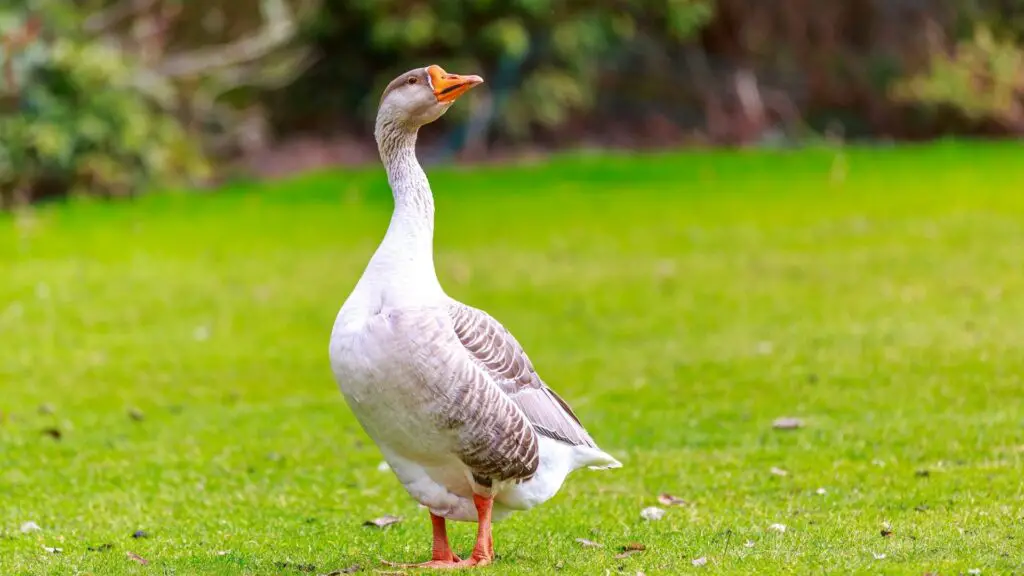
Appearance
Emden geese are pure white, with an upright body, a yellow to the orange bill, and well-rounded breasts. They also have ocean blue eyes, a long, slender neck, and a dual-lobed paunch. Their legs and feet are orange but very short, while their wings are close and very hard. This goose breed has a long back and a short tail.
Lifespan
As a commercial bird, the Emden (or Embden) goose has a lifespan of 20-25 years.
Height
The Emden goose is one of the biggest goose breeds in the world and is also the tallest goose breed, standing at 3.3 ft tall. But because the Emden goose has no “knob” on its forehead, this bird seems to have smaller heads than others.
Weight
An adult Emden goose weighs about 22 lbs (10 kilos). Nonetheless, the ones that are in the UK are much heavier than the original German version.
Place of Origin
As the name suggests, the Emden goose originated in Emden Germany, an independent city formerly known as Embden. This white goose breed is one of the oldest domesticated goose breeds in the world. It was standardized by the Poultry Club of Great Britain (PCGB) in 1865 and was admitted to the APA in 1874.
The exact history of Emden geese is not known, but it is believed to be directly from the French Toulouse goose breed. Another theory is that the Emden goose might be a cross between a German white goose and an English white goose. But then, not all white geese are necessarily considered Emden geese.
Characteristics
The Emden goose is known for being very quiet and docile. It is a great forager, cold hardy, and prefers to live near some water and a great forager. This goose breed grows faster than most breeds, making them famous for meat production. Young geese mature as early as 2 months. Males are quite aggressive, though.
Sebastopol Goose
Appearance
The white Sebastopol goose has elegant, curly feathers all over its body and tail. Because of its spiraled feathers, this white goose breed looks bigger than its actual size. The head and upper neck plumage are not curly, though. Some strains may also have smooth feathers on their breast instead of curly.
The Sebastopol goose has striking blue eyes, an orange beak, and a round head. It also has keelless breasts and short thighs and legs. Aside from pure white, Sebastopol geese have two more color varieties – gray and the bluff. White is the most common, and the other two have not been recognized yet.
Lifespan
Adult Sebastopol geese have an average lifespan of about 25 years.
Height
There are no official body measurements of the Sebastopol goose, but it is described as a medium-sized breed.
Weight
Adult Sebastopol geese weigh about 12-14 lbs (5.4-6.4 kilos).
Place of Origin
The Sebastopol goose originated in Sebastopol, Crimea, hence the name. It was believed to have been introduced into the UK in 1859 and was later brought to the US. It first appeared in an exhibit in the UK in 1860. A descendant of the wild Greylag goose, this goose breed was recognized by the APA in 1938.
In Germany, the Sebastopol goose was sometimes called Lockengans and Struppgans, which means “curl-goose” and “unkempt goose”. Interestingly, these names somehow fit the bird’s distinct physical appearance. In Ireland, the bird was called the Danubian goose as a synonym during the mid-19th century.
Characteristics
Sebastopol geese are bred as ornamental birds but are also good for producing meat and eggs. They are also friendly and quiet pets. But because of its curly feathers, it needs lots of water so it can clean itself regularly, especially in the summer. This is also the main reason why Sebastopol geese cannot fly well.
Roman Tufted Goose
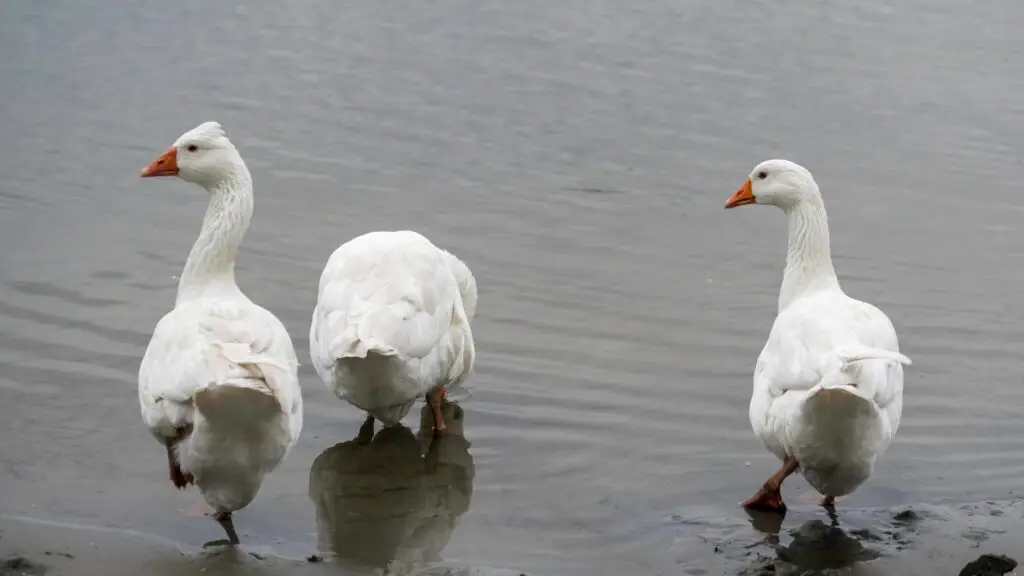
Appearance
Roman Tufted geese have pure white plumage, although some strains may have bluff or gray feathers. This majestic goose breed has bright blue eyes, pinkish beaks, and reddish-orange beaks and legs. They also have strong wings. Their bodies are small but stout and well-rounded, while their necks have medium length.
Roman Tufted geese have a light dual-lobed paunch and a very distinguishing crest on the crown. This cylindrical tuft of feathers starts at a line from the back of the eyes and is somewhat inclined backward. Note, however, that some white goslings may have gray markings but will fade once they are about 1 year old.
Lifespan
Just like most goose breeds, the Roman Tufted goose has an average lifespan of 25 years in the wild.
Height
There are no records showing the body measurements of Roman Tufted geese. Nonetheless, they are considered a small-sized goose breed.
Weight
Adult male Roman Tufted geese weigh approx.12 lbs (5.4 kilos), while adult females weigh about 10 lbs (4.5 kilos). Young ganders may weigh around 10 lbs, while young geese may weigh 9 lbs (4 kilos).
Place of Origin
The Roman Tufted goose is an Italian domesticated goose breed that has been around for over 2,000 years. In the late 4000 BC, the Gauls tried to invade Rome, but a Roman goose squawked very loudly and woke up Marcus Manlius. The capital was saved, and the goose was considered sacred to goddess Juno.
Characteristics
In North America, this Roman goose breed was bred as ornamental birds because of the tuft of feathers on its crown. Hence, the bird was called Roman Tufted goose. This goose breed was admitted to APA’s Standard of Perfection in 1977. In Europe, the Roman goose has no tuft and is treated as a meat bird.
As a pet, the Roman Tufted goose is generally friendly and easy to handle. Despite not belonging to a large breed, they are alert and can be very dependable watchdogs. Roman Tufted geese also have a huge potential for being meat producers. On the other hand, females are moderate egg layers.
Czech Goose
Appearance
All Czech geese have pure white feathers, and the breed has no other color variation. They have a sturdy body, a slightly curved neck, and a small single-lobed paunch. Czech geese possess slightly-broad shoulders, a small but round head, and a slightly-arched forehead. Their beaks, legs, and feet are orange-red.
The Czech goose has two forms – those with a crest on its head and those without. The Crested Czech goose has a feather tuft on top of its head and was recognized in 1988. On the other hand, the non-crested Czech goose has a smoother and more rounded head and is more famous than the crested form.
Lifespan
The Czech goose has an estimated lifespan of 10-15 years.
Height
Czech geese are considered medium-sized birds, although there are no reports comparing them to the size of other goose breeds.
Weight
Male Czech geese weigh about 5-5.5 kilos (11-12 lbs), while females weigh 4-4.5 kilos (8.8-10 lbs).
Place of Origin
The Czech goose originated in Bohemia (now known as the Czech Republic), where it was called Ceská husa. In the 1960s, these Bohemian geese were brought to the German Democratic Republic and were called Tschechische gänse. The Czech goose was standardized in the British Poultry Standards in 2008.
Characteristics
Not to be confused with Slovak white geese, Czech geese are very loud birds and thrived well in wet meadows. Females can lay 10-20 eggs a year and are excellent mothers. As a hardy breed, adults can tolerate cold weather conditions. Aside from being meat and egg producers, they are bred for their pricy feathers.
White Chinese Goose
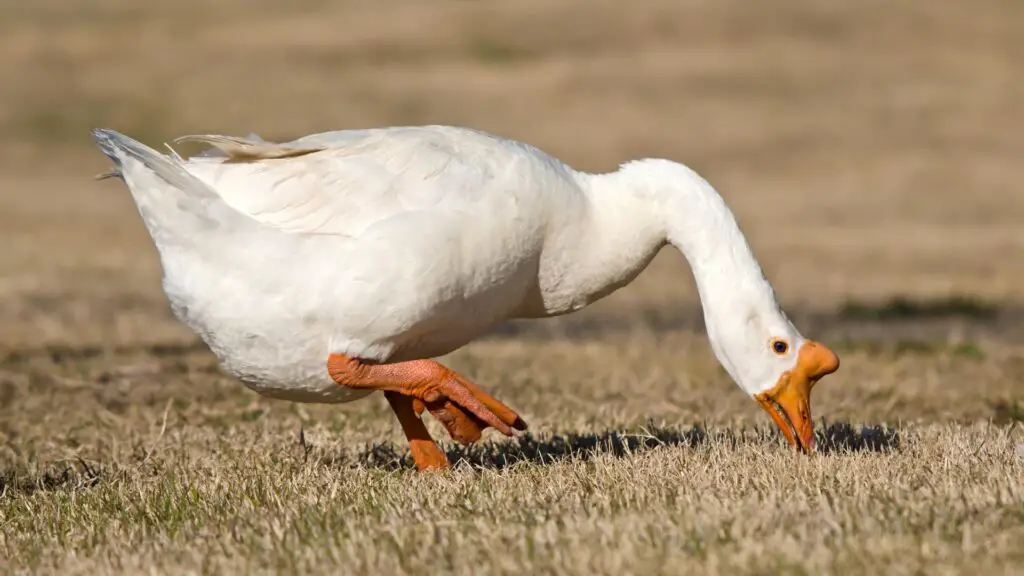
Appearance
The white Chinese goose has pure white plumage, a short body, and a well-rounded chest. They can easily be distinguished by the prominent “knob” on their forehead. These elegant-looking geese also possess an unadorned throat and a well-arched neck connected to the body at an angle of about 45 degrees.
Lifespan
White Chinese geese have an estimated lifespan of 10-20 years.
Height
The white Chinese goose is considered a small-sized breed, standing 2-3 feet tall and 1-2 feet long.
Weight
Adult male white Chinese geese weigh around 5.5 kilos (12 lbs), while adult females weigh around 4.5 kilos (10 lbs).
Wingspan
Adult white Chinese geese have a wingspan of between 160 and 185 cm (63 and 73 inches).
Place of Origin
The white Chinese goose is an international goose breed that originated in China, hence the name. They are also sometimes referred to as “swan goose” not only because they are its direct descendants but also because of their long, graceful necks. Aside from the white form, Chinese geese also come in brown.
Characteristics
Both color varieties were admitted to the APA’s Standard of Perfection in 1874, and are common in North America and the UK. Amazingly, females can lay up to 100 eggs annually if managed well. Chinese geese are also very alert and loud when threatened. They can be aggressive if provoked or to defend their nest.
But despite their small sizes, Chinese geese are widely known for being excellent watchdogs on lawns and farms. They are also nicknamed “weeder geese” for being active foragers and excellent watchdogs. This versatile goose breed is low-maintenance, can tolerate cold temperatures, and is great at producing meat.
Frequently Asked Questions
Are White Geese Male or Female?
Just like other goose breeds, white geese can either be male or female. A male goose is called a gander, while a female goose is called a dame. The term “goose” is not referred to a specific gender, but it can be referred to as “female” when paired with a male goose. Therefore, it depends on how you use the word “goose.”
How Can You Tell a Female White Goose?
In general, female white geese are smaller than males. Meanwhile, females have lower-pitched honks than males and a monotone voice. However, some goose breeds, such as the West of England and Pilgrim geese have different colors and markings for males and females. As mentioned above, this is called autosexing.
If you want to make sure of the gender of a goose, you can check its vent. Just like ducks and swans, male geese have a corkscrew-shaped penis. But then, they retract their penises inside their bodies when not needed. If they don’t appear, you can touch the vent. Males have a hard mass, while females are soft.
Why Do Geese Honk?
Geese honk due to various reasons. Mother geese usually honk to scare away the people or other animals that go near their young. Male geese honk to declare their territorial boundaries and to attract females. When migrating, geese fly in a “V” formation. They honk allowed to maintain the integrity of the flock in the air.
White geese are a wonderful sight, especially if they are pure white. Regardless of color, geese are highly social creatures. But again, some breeds are naturally aggressive and cannot be domesticated. On the other hand, domesticated geese are great in meat and egg production. They are also efficient weed control agents.
Related: White Geese Breeds | Facts and Photos
